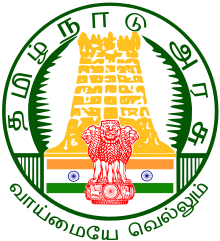Kayalpatnam
Kayalpattinam (also known as Kayalpatnam or Kayalpattanam Tamil - காயல்பட்டினம்) is a Municipality in Thoothukudi district in the Indian state of Tamil Nadu. As of 2011, the town had a population of 40,558.
Kayalpattinam | |
|---|---|
| Nickname(s): Kayal | |
 Kayalpattinam Location in Tamil Nadu, India  Kayalpattinam Kayalpattinam (India) | |
| Coordinates: 8°33′59″N 78°6′59″E | |
| Country | |
| State | Tamil Nadu |
| District | Thoothukudi (formerly V.O.C.) |
| Government | |
| • Body | Kayalpattinam Municipality |
| Area | |
| • Total | 12.5 km2 (4.8 sq mi) |
| Population (2011) | |
| • Total | 40,588 |
| • Density | 3,200/km2 (8,400/sq mi) |
| Demonym(s) | Kayalan |
| Languages | |
| • Official | Tamil |
| Time zone | UTC+5:30 (IST) |
| PIN | 628204 |
| Telephone code | 04639 |
| Vehicle registration | TN 92 (Thiruchendur RTO) |
| Nearest city | Thoothukudi |
| Sex ratio | 1000:1177 ♂/♀ |
| Literacy | 92.71% |
| Lok Sabha constituency | Thoothukudi Formerly with Tiruchendur |
| Vidhan Sabha constituency | Tiruchendur |
| Civic Agency | Kayalpattinam Municipality |
| Climatei | Humid (Köppen) |
History
Also known as Kayal, it is referred to in Marco Polo's[1] travel diaries dating to 1298 AD. Korkai[2] or Kayal was an ancient port dating to the 1st centuries of the common era and was contemporaneous to the existence of Kollam, another Pandyan port. Kollam served the Pandyas on the west coast while Korkai/Kayal served them on the east coast connecting them to Ceylon and the pearl fisheries in the Gulf of Mannar facing the Tirunelveli Coast. Arab traders from Egypt and Yemen landed at the port of Korkai (the present Kayalpatnam). some traders migrated to Adirampattinam. Strong trading connections existed with (Sri Lanka). There exist a strong cultural connection between Kayalpattinam, Adirampattinam and Kilakarai. Most of the Muslims here are matrilocal residents. The ancient port had trade connections with Egypt, Rome and Greece
Kayalpatnam has one of the oldest Mosques (also known as Masjid). Noted photographer Benoy Behl has made a film on Islamic Architecture of India, and he visited this Kayalpatnam Mosque.[3]
Ibn Battuta, the Muslim Moroccan explorer has mentioned about Kayalpattinam (as called as Fatan) in his travel node the Rihla (lit. "Journey").
Demographics
According to 2011 census, Kayalpattinam had a population of 40,588 with a sex-ratio of 1,082 females for every 1,000 males, much above the national average of 929.[4] A total of 4,995 were under the age of six, constituting 2,548 males and 2,447 females. Scheduled Castes and Scheduled Tribes accounted for 7.37% and .01% of the population respectively. The average literacy of the town was 81.3%, compared to the national average of 72.99%.[4] The town had a total of : 9417 households. There were a total of 11,414 workers, comprising 17 cultivators, 27 main agricultural labourers, 206 in house hold industries, 10,717 other workers, 447 marginal workers, 9 marginal cultivators, 4 marginal agricultural labourers, 30 marginal workers in household industries and 404 other marginal workers.[5]
As per the religious census of 2011, Kayalpattinam had 26.34% Hindus, 67.24% Muslims, 6.36% Christians, 0.01% following other religions.[6]
Culture
Most of Muslims here follow Shafiee Madhab with Qadiriyya and Shadhiliya Tariqa (Sufi order) Qadiriyya tariqa connected to Mahlara and Shadhiliya tariqa connected to zaviya Faasiyatush shadhiliya Tariqa. Headquarters of this tariqa[7] in India Zaviathul Fasiyathus shathulia is located here. There are few followers of ahle hadees also. Maqbara of Hazrat Kazi Syed Alauddin brother of Hazrat Kazi Syed Tajuddin the fore father of Madurai Maqbara Hazrats'[8] and of all the Syeds living in Kazimar Street, Madurai is located here.
References
- M. Polo refers in fact to Pazhaiyakayal (Old Payal), which is 15 km north of actual Kayalpatnam. See Roderich Ptak, Yuan and Early Ming Notices on the Kayal Area in South India, 1993.
- Korkai, mentioned by Ptolemeus, is 4 km S-W of Old Kayal. See Roderich Ptak, ibid.
- Indian Diplomacy (12 July 2011), A World of Beauty and Grace: Islamic Architecture of India, retrieved 13 April 2017
- "Census Info 2011 Final population totals". Office of The Registrar General and Census Commissioner, Ministry of Home Affairs, Government of India. 2013. Retrieved 26 January 2014.
- "Census Info 2011 Final population totals - Kayalpattinam". Office of The Registrar General and Census Commissioner, Ministry of Home Affairs, Government of India. 2013. Archived from the original on 24 September 2015. Retrieved 26 January 2014.
- "Population By Religious Community - Tamil Nadu" (XLS). Office of The Registrar General and Census Commissioner, Ministry of Home Affairs, Government of India. 2011. Retrieved 13 September 2015.
- http://www.shazuli.com/aboutus.html
- http://maqbara.com/genealogy.php
